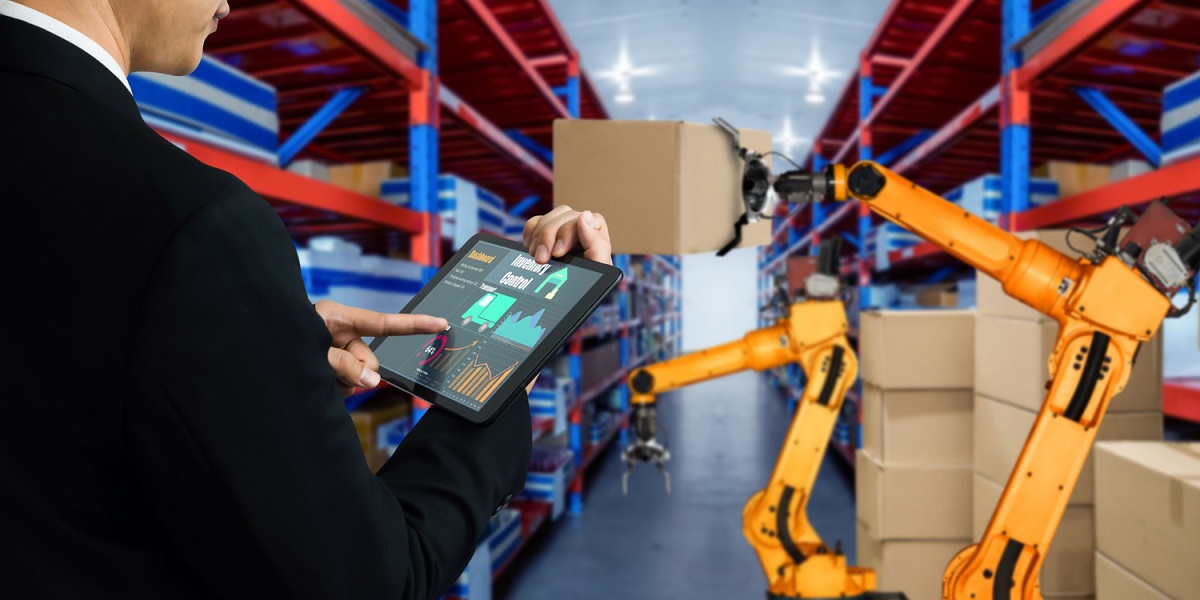How AI and Automation Are Transforming Logistics: A Complete Guide

Introduction
The logistics industry is experiencing what seems to be the most radical revolution as we speak. AI in logistics is revolutionizing the supply chain to make it faster, smarter, and more efficient than we can almost comprehend.
Software development companies present new inventions in the niche using artificial intelligence to solve traditional logistics problems on a daily basis. From robotic warehouses to autonomous trucks, there are signs that the future of the logistics industry is becoming high-tech.
Evidence of Importance
Current research proves that about 73% of logistics companies use AI or automation in their work, increasing the general effectiveness in the sphere by 30%.
The impact of AI technologies is predicted to be valued at over $12 billion by 2027, and automation in the logistics industry is growing at an exponential rate of 24% annually. At the same time, digitization in logistics is paged at over $46.5 billion by 2025, with a 21.7% YOY jump.
Synopsis
This guide looks at how organizations are currently utilizing AI in the logistics industry, the advantages and disadvantages of the implementation of such technologies, and what can be done to ensure that players in this industry can harness this digital change successfully.
The Current State of Logistics and the Need for Transformation
Challenges in Traditional Logistics
Challenges in traditional logistics operations include extensive paperwork, human error, and inefficiencies. To overcome these obstacles, leveraging advanced logistics software solution can help reduce errors, streamline processes, and improve overall efficiency. These partnerships can also assist in managing higher operational costs, labor shortages, and elevated customer expectations, ensuring a competitive edge through technology.
Why AI and Automation Are Key Solutions
AI-based solutions and software for supply chain management and logistics give insights, improve routes, and decrease mistakes. These technologies assist firms in working better, more effectively, and in a short span of time in the current world economy.
Key AI and Automation Technologies in Logistics
Machine Learning (ML) and Predictive Analytics
Logistics uses artificial intelligence to study vast amounts of data on the market demand, risks, and cost of supply chains. Machine learning in logistics takes the logistical supply chain to the next level by automating complex daily tasks.
Big Data and analytics track the conditions of equipment and display the subsequent maintenance and repair requirements, minimizing breakdown logs and expenses in logistics companies.
Robotic Process Automation (RPA)
Some of the tasks in logistics, such as order processing and inventory management, can be heavily aided by robotic process automation in the logistics industry to relieve ordinary employees from their mundane tasks.
Internet of Things (IoT) and Sensors
Implementations of IoT include optimum tracking of the whereabouts of shipments in real-time, determining and tracking the temperature conditions of delivery, and ensuring security through connected sensors.
Autonomous Vehicles and Drones
In the domain of logistics, where ‘last mile’ delivery holds the key to the consumer end, self-driving trucks and delivery drones are changing the face of route delivery with optimal utilization.
Despite the great potential, the adoption of autonomous vehicles in logistics for urban delivery is limited by safety rules and public perception.
Computer Vision and Natural Language Processing (NLP)
The computer vision systems perform crucial warehousing tasks such as identification, sorting and tracking of packages with superior precision and efficiency.
NLP helps reuse chatbots and document processing systems, provides customer support, and minimizes the paperwork in logistics operations.
Major Applications of AI and Automation in Logistics
Warehouse Automation
Automated warehouses may take the form of robotized ones where the use of robots and artificial intelligence cut down the workforce greatly in such tasks as picking, sorting, and packing.
Amazon's automated warehouses demonstrate that using AI and robotics in logistics can handle millions of items with unprecedented daily precision.
Supply Chain Optimization
Real-time supply chain reactivity and dynamic inventory control avoided delay through the application of algorithms, which highlight potential problems in AI-driven supply chain optimization.
This way, the business is able to utilize elaborate algorithms to determine better markets and data to make the right supply chain choices.
Route Optimization and Fleet Management
AI systems determine the degree of optimization of delivery routes based on traffic, weather conditions, and vehicle load.
UPS’ Orion system shows how a firm can prevent millions in fuel costs and decrease delivery time substantially.
Inventory Management
Predictive analytics in logistics enable the appropriate availability of stocks in an organization by minimizing the overstock status.
By nature, MRP is efficient for responding to changing consumption patterns based on the seasons and monitoring perishable products during the supply chain process.
Customer Experience Enhancement
This is made possible through the use of artificial intelligence-based chatting services that offer instant replies to customer questions and real-time logistics tracking.
AI-based tracking systems offer customers accurate and immediate estimates for when their orders will be delivered and if, for any reason, the order will be delayed.
Benefits of AI and Automation in Logistics
Cost Reduction
Logistics automation greatly reduces labor expenses, achieves less fuel consumption through the shortest routes, and narrows the operating cost of warehouses.
Increased Efficiency and Productivity
AI systems perform orders round the clock, process them more quickly, and control resources better than generic manual operations.
Enhanced Accuracy and Reduced Errors
AI systems minimize human errors in order processing, inventory count and generation of shipping labels, thus enhancing accuracy in the system.
Better Decision-Making and Real-Time Insights
AI gives rapid insights into logistic information; thus, it helps organizations to make better decisions about performing tasks such as routing and inventory as well as managing resources.
Sustainability
Advanced techniques of routing and other related systems have apparently minimized the emission of carbon. In contrast, the intelligent use of AI and sustainability in logistics makes green supply chain logistics a reality.
Challenges and Risks of Implementing AI and Automation in Logistics
High Initial Costs
Logistics automation is still in the process of development, and as such, it costs a lot of money in the form of technology investment, infrastructure, and human resource training.
Data Privacy and Security Concerns
Since logistics companies deal with essential and personal information, corporations have to apply strict security measures against threats and cyberattacks.
Workforce Adaptation and Skill Gaps
Management must ensure they provide training in order to avert technology-driven resultant loss of jobs.
Integration with Existing Systems
Introducing new AI systems to an organization’s logistics software ecosystem with a logistics mobile app comes with significant compatibility issues.
Future Trends in AI and Automation for the Logistics Industry
Advances in Autonomous Deliveries
Self-driving transport in logistics is going to evolve: better trucks, new inventions, including delivery robots, as well as self-loading cargo vehicles.
AI for Sustainable Logistics
It was pointed out that AI will play a role in green solutions for logistics in the supply chain, with the possibility of better packaging and improved routing.
Blockchain Integration
Logistics industry trends in 2024 suggest that blockchain applied to AI will transform global shipping documents and improve the supply chain’s credibility and safety.
Enhanced Predictive Analytics and AI-Driven Planning
Sophisticated AI tools will be used to enhance demand forecasting and risk management, which will increase their effectiveness.
The Role of AI in Global Trade and Cross-Border Logistics
Leveraging this technology, customs formalities and international shipping documents shall be expedited so as to enhance AI supply chain optimization.
Steps to Successfully Implement AI and Automation in Logistics
Assessing Business Needs and Goals
First of all, they need to determine the directions that will bring the maximum effectiveness of AI and automation approaches in logistics.
Choosing the Right Technologies
Consult a competent software development firm in choosing and deploying the right AI solutions that will suit your business.
Building a Skilled Workforce
Set up training sessions for your staff to give them the knowledge and skills to fully appreciate and work with the new implementation of AI and automation in the logistics industry.
Partnering with Reliable Technology Providers
It is recommended to select contractors that already have successful experience in providing logistics automation services.
Ensuring Data Management and Cybersecurity
Read: Set a robust data protection plan and perform security checks at least once every quarter to protect your AI systems.
Continuous Monitoring and Optimization
You should continuously monitor the nature of system performance that delivers the automation tools in logistics, so make proper modifications.
Case Studies of AI and Automation in Logistics
Amazon's Warehouse Robotics
Amazon is applying more than three hundred and fifty thousand mobile robotics in the automated warehouses, processing millions of packages with an efficiency of 99.99% error rate.
UPS's Orion System
UPS estimates that AI route optimization delivers $400 million of value per year through faster delivery and minimized fuel usage.
DHL's Predictive Analytics
DHL’s artificial intelligence algorithms for its shipping operations estimate delivery delays up to 10 days in advance to avoid 85% of supply chain failures.
FedEx's IoT Implementation
The integrated SenseAware solution of FedEx enables tracking of package conditions in real-time to safely deliver goods in various locations and routes.
Conclusion
Key Takeaways
Great things done by AI in the logistics industry are still fascinating to those who are working in this industry: new solutions appear regularly, and they address various problems.
The future of the logistics industry is intertwined with these technologies because the use of AI and automation becomes critical for competitiveness.
Future Outlook
The future of AI in logistics will remain an active topic for discussion and application as new highly advanced solutions for automation and improvement will be developed.
AI, robotics, and automation ideas are going to be integrated into the logistics industry, which is going to result in improving complex supply networks.
Are You Future-ready
Do not delay in getting your logistics operations into the 21st century. Choose a reliable software development company as your ally in the introduction of AI into your enterprise now.
FAQs
1. What are the key benefits of automation in logistics?
Specified benefits of automation include less cost, accurate results, faster results, and round-the-clock service. It also enables firms to increase operation size while at the same time ensuring quality.
2. How does AI improve supply chain efficiency?
AI is used by supply chains to calculate appropriate routes, estimate demand or potential disruptions, and make decisions, thus making supply chains faster and more adaptive.
3. How can AI help reduce logistics costs?
It reduces fuel consumption, makes timely and correct decisions as to resources, cuts down mistakes, and automates mechanical work, thus saving on costs.
4. What are the main benefits of AI in the logistics industry?
With the help of AI, it is possible to predict better, automate processes, enhance customers’ experiences, and even decrease all the costs of running the business or increase the total efficiency.
5. What is predictive analytics, and how does it help logistics companies?
Predictive analytics means the use of artificial intelligence where a company is in a position to predict demand, when product maintenance may be required, or when a disruption may occur.
6. How does automation reduce logistics costs?
This means that manual labor costs will be avoided, errors reduced, and resources fully utilized around the clock, leading to efficient, round-the-clock operations.
7. What is the future of AI in the logistics sector?
The future of implementation alternatives involves self-driving cars, intelligent storage, better prognostics, and the integration of AI with operations.
8. How do robotics and automation improve logistics productivity?
Robots and automated systems work continuously, process orders faster, and handle repetitive tasks more efficiently than manual operations.
Hyperlink InfoSystem - Most Trusted End-to-End development Solution Provider.
Write For Us





